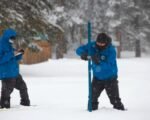In the serene wilderness of Canada’s Yoho National Park, a rare and beautiful anomaly of nature met a tragic fate. Nakoda, the famed white grizzly bear known for her strikingly light fur, became a symbol of the park’s wild majesty. However, the recent news of her death, following the loss of her two cubs in separate vehicle collisions, has cast a shadow over the wildlife community and sparked a conversation about human impact on nature’s delicate balance.
The Rarity of Nakoda’s Lineage
Nakoda’s unique coloration was not just a rarity; it was a beacon of natural wonder that drew the attention of wildlife enthusiasts and photographers from around the world. Her presence was a reminder of the diversity within the animal kingdom and the genetic marvels that can occur. The loss of Nakoda and her cubs is not just an emotional blow to those who followed her story but also a significant loss to the biodiversity of the region.
The white grizzly bear, a genetic rarity, was a testament to the unpredictable beauty of evolution. Nakoda’s existence challenged the commonly held perceptions of what a grizzly should look like and served as a living example of nature’s capacity for variation.

The Circumstances of the Tragedy
The circumstances surrounding Nakoda’s death are a stark reminder of the dangers wildlife face in proximity to human development. The bear and her cubs were struck by vehicles on the Trans-Canada Highway, a busy thoroughfare that cuts through their natural habitat. This tragic event highlights the need for increased measures to protect wildlife from the ever-present dangers of roads and human encroachment.
The incident has prompted calls for better protective measures, such as wildlife corridors and fencing, to ensure safe passage for animals across these human-made barriers. The death of Nakoda and her cubs serves as a poignant example of the consequences when such measures are lacking or insufficient.
Reflections on Coexistence and Conservation
Nakoda’s story is a somber reflection on the relationship between humans and wildlife. It raises questions about how we can coexist with nature without causing harm to its inhabitants. The conversation about conservation is now more critical than ever, as each loss reminds us of our responsibility to protect these creatures and their habitats.
As we mourn the loss of Nakoda and her cubs, we must also look forward to the steps we can take to prevent similar tragedies. It is a call to action for conservationists, policymakers, and the public to work together to create a safer environment for all wildlife.













